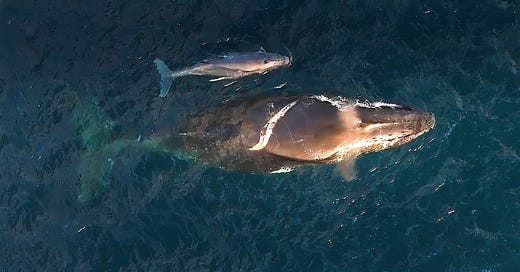Welcome to the latest edition of the Big Blue Bulletin – things have changed just a little bit around here as featured stories will now focus on whales, dolphins, and porpoises, with a little bit of commentary from me thrown in as well. Still, you can expect good news, bad news, and a cute creature in your inbox every Friday.
Let’s dive in 🐬
Ocean news
🗞️ Big news of the week -
🇦🇺 Researchers puzzled as baby whales spotted in unexpected places along Australia’s ‘humpback highway’
A study published in Frontiers in Marine Science has recorded more than 200 sightings of newborn calves far from their usual birthing zones, including as far south as Tasmania and even near New Zealand.
Humpback whales in Australia are known for making one of the longest migrations on Earth as they breeding in the tropics before heading south along the so-called “humpback highway.” However, this new research suggests the map may need redrawing.
Scientists say these expanded birthing zones means calving may not be limited to warm northern waters after all. Instead, breeding and birthing could be more flexible than previously thought which raises new questions about how the species are successfully adapting to a changing ocean.
🏴 Rare whale spotted on Scottish west coast 'for first time in 20 years'
A beluga whale has been seen swimming in Loch Broom on the north-west coast of Scotland, marking the first confirmed sighting in the region in two decades.
Belugas usually stick to Arctic waters around Canada and Alaska, making this a rare and surprising visit. According to the Hebridean Whale and Dolphin Trust, belugas have only been recorded in Scottish waters a handful of times, with the last in Shetland earlier this year.
Climate shifts and changing ocean conditions is likely what brings the cold-water species further south and into unusual territory.
🦴 Ancient Patagonian fossil sperm whale may have been active predator
In a new study, researchers reanalysed the only known specimen of a fossilised sperm whale (Idiorophus patagonicus), first unearthed in Argentina's Gaiman Formation more than a century ago. The 20-million-year-old fossil has revealed surprising clues about how early species in this family might have hunted.
Unlike modern sperm whales, which rely on suction feeding to catch squid in deep waters, this ancient relative may have been an active predator of large fish and even seabirds. Its skull shape suggests a more dynamic, pursuit-based hunting style.
The discovery sheds new light on the diversity of feeding strategies among early toothed whales and just how much we can still learn from the fossil record.
👓 Humpback whales can’t see as well as scientists thought
Despite having enormous eyes, it turns out humpback whales may not be able to see all that clearly. A new study has found their eyesight is surprisingly poor, especially when it comes to spotting nearby obstacles like fishing gear.
Scientists dissected the eye of a juvenile humpback and found a shorter-than-expected focal length and a low density of retinal ganglion cells — both signs of weaker vision. Using computer models, they simulated how the whales likely see underwater and discovered they can only make out fine details within three to four body lengths. This likely wouldn’t give them enough notice to avoid the many fishing nets in front of them.
The findings, published in Proceedings of the Royal Society, could help explain why humpbacks are among the most frequently entangled whales. But poor eyesight can easily be forgiven, masses of ghost gear and death traps in the ocean, cannot.
🧊 Climate change poses severe threat to bowhead whale habitat
A new study has found that climate change could wipe out up to three-quarters of bowhead whale’s summer foraging habitat by 2100. Regions like the Sea of Okhotsk are a summer habitat to one of the four populations of bowhead whales but it could disappear completely by 2060.
Bowhead whales are uniquely adapted to the Arctic and have followed sea ice extent for over 11,000 years. But new modelling shows their reliance on seasonal sea ice could be their undoing as climate-induced sea ice loss could contract by up to 75%. Despite past climate shifts, their habitat had remained stable until now.
Published in Ecology and Evolution, the research combined fossil records, whaling data, and computer modelling to reconstruct bowhead habitat across the Holocene.
🇺🇸 Lawsuit filed in effort to protect endangered Rice's Whales in the Gulf
With only around 50 individuals left (an estimation taken almost 10 years ago), Rice’s whales are considered the most endangered whales on Earth. Now, environmental groups are taking legal action to try and save them.
A new lawsuit is calling for stricter protections in the Gulf of Mexico, where the whales live year-round. The case follows a recent federal ‘biological opinion’ that acknowledged oil tankers and vessel strikes are likely to jeopardise the species' survival but failed to propose strong enough measures to prevent it.
NOAA Fisheries Service estimates that over the next 45 years, nine Rice’s whales would likely die with three more seriously injured. But Chris Eaton, an attorney with the environmental group Earthjustice, estimates that even one female death could push the species toward extinction.
Campaigners want mandatory ship speed limits and a 500-yard buffer zone around any visible whale. This legal challenge aims to hold federal agencies accountable for protecting a species that’s already hanging by a thread.
Have a great weekend! 📸
Cover image by Vanessa Risku





I am always encouraged when I see reports such as the humpback calves sighted in unexpected locations, hopefully suggesting species resiliency is better than we reckon.
Would that sperm whale have counted as macroraptorial?